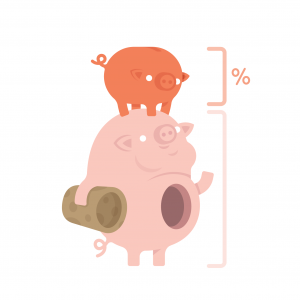This article explains how savings grow by accumulating interest.
In an economic climate when interest rates are low, savings growth may be minimal, so you might want to weigh up the benefits of saving against other options for your spare cash. But bear in mind that once interest rates start to rise, any lump sum you have saved will grow faster. In the mean time, it’s particularly important for savers to shop around, to find the best deals to maximise returns.
Why Save?
Get into the habit of saving and you will find that putting away a little money regularly soon mounts up, and grows thanks to the interest it accumulates (even little by little!)
Savings accounts can provide a great way to gradually build a lump sum, for a particular purchase or just as insurance for the future to give you peace of mind. Once you are earning a sufficient amount and have paid off any costly debts, think about starting to save.

Start by building up a fund for emergencies, such as car repairs or replacing household items.
MoneyHelper recommends having about 3 months’ essential outgoings readily available in an Easy Access savings account, where you can get at your money quickly if you need to.
Then try to save regularly, gradually accumulating resources for longer-term goals like a car, holiday, deposit on a property etc. You could set up a standing order for a monthly payment into a savings account.

Earnings from Savings – Interest
Interest is earned from leaving your money in a bank account or savings – effectively the fee the bank pays you for ‘borrowing’ your money. The interest rate is usually expressed as an annual percentage of your deposit (the ‘principal’).

Calculation of Interest: Compound or Simple
A savings deposit accumulates a certain amount of interest at regular intervals; interest may be added monthly, quarterly, annually, or even daily – and the more frequently it happens, the faster savings grow. The amount of Interest is calculated by either the compound or simple method:
Compound Interest
With compounding, interest is calculated on the principal deposit PLUS accumulated interest – so over the year, the interest earns interest. Therefore savings grow faster every year they are left in an account.
Most UK savings and current accounts pay compound interest, but always check with the provider.
Simple Interest
This method generates a lower amount of interest, because it is calculated only on the principal deposit – i.e. you do not earn interest on the accumulated interest. Savings grow at the same rate every year.
AER: Annual Equivalent Rate
The advertised rate for most savings products refers to gross interest – the ‘flat’ annual rate earned before tax and any charges have been deducted. But gross rates can be deceptive when comparing options, because some refer to monthly interest whilst others quote annual rates, and they disregard the effects of compounding.
A better measure of return on investment is the Annual Equivalent Rate (AER), which is quoted on all savings and current accounts (when your balance is in credit).
AER shows how much interest would be earned if money was left in an account for one year
AER is a yearly rate, expressed as a percentage of the original amount deposited (the principal).
Example:
If you deposited £1000 in a savings account for one year at 5% AER, you would earn £50 interest
The AER takes into account the interest rate %, the effects of compounding and how often interest is paid, as well as any charges. It is calculated in a standardised way, so you can easily compare different savings and bank accounts.
Comparing AERs gives you a general indication of which savings will give the best return, if you intend to keep your money in the account for a year. However, when you are weighing up options, you need to be aware of how certain factors can affect interest payments, and you should always compare the actual rates you would receive:
- AER does not take account of any tax you might have to pay on savings income
- You won’t automatically be offered the advertised AER (banks sometimes attract new savers with high interest rates, but pay less to existing customers)
- Inflation, the type of interest rate (fixed or variable) and any introductory bonuses will also have an impact on interest payments, and should be taken into account when choosing savings products
Savings will grow faster:
If interest is calculated using the compounding method
The higher the % interest rate (AER)
The more frequently interest is added or compounded
The longer savings remain untouched (no withdrawals)
Find out more:
Understand Interest Rates – How much Interest do You Earn?
AER, fixed & variable rates, simple & compound calculation methods, gross & net interest
Choosing Savings Accounts
Interest payments – what sort of return do you want?

